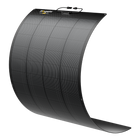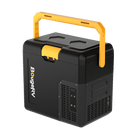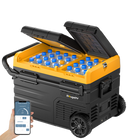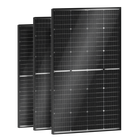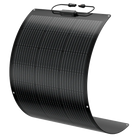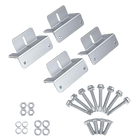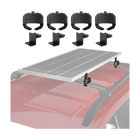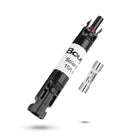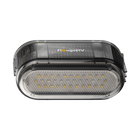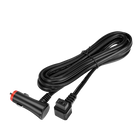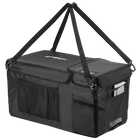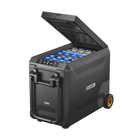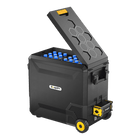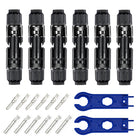How Do Portable Air Conditioners Work?

When the sweltering heat of summer rolls in, many of us look for convenient and efficient ways to cool our homes, workplaces, and even camping tents. One popular solution is the portable air conditioner. These versatile units offer the flexibility to move cooling power from room to room, making them an attractive option for temporary or supplemental cooling.
But how exactly do portable air conditioners work? In this comprehensive guide, we'll dive into the mechanics behind these handy devices, highlight their benefits, and provide tips on choosing the right one for your needs.
Portable Air Conditioners
Before diving into the details of how portable air conditioners function, it's essential to understand what they are. Unlike window-mounted units, portable air conditioners are standalone devices that sit on the floor. These versatile machines are suitable for both home and outdoor use, requiring minimal installation.
Home portable air conditioners typically come with wheels for easy mobility. They usually just need a simple venting kit to expel hot air through a window or wall opening.
In contrast, portable air conditioners designed for outdoor camping and overland use are more compact and energy-efficient. These units effectively cool your tent, ensuring you stay comfortable and enjoy every moment during hot summer days.
The Basic Components of a Portable Air Conditioner
To understand how portable air conditioners work, let’s familiarize ourselves with their basic components. A portable air conditioner functions similarly to other types of air conditioning units, utilizing the same fundamental principles of thermodynamics. Here are the basic components that make up a portable air conditioner:
-
Compressor: This is the heart of the unit. It compresses the refrigerant gas, raising its temperature and pressure.
-
Refrigerant: This is a special fluid that cycles through the unit, absorbing and releasing heat as it changes between liquid and gas states.
-
Evaporator Coil: Located inside the unit, the evaporator coil absorbs heat from the room air, cooling it down.
-
Condenser Coil: Situated outside the unit, usually near the vent, the condenser coil releases the absorbed heat to the outside air.
-
Fan: There are usually at least two fans—one to circulate the room air over the evaporator coil and another to expel the hot air over the condenser coil.
-
Exhaust Hose: This is used to vent the hot air out of the room, typically through a window.
How Portable Air Conditioners Operate

Now that we know the components, let’s take a look at the operation of a portable air conditioner. The operation of a portable air conditioner can be broken down into several key steps. These include absorbing air, cooling the air, and expelling the heat outside.
-
Air Intake: The air conditioner draws in warm air.
-
Cooling Process: The warm air passes over the evaporator coil. The refrigerant within the coil absorbs the heat from the air, causing the refrigerant to evaporate into a gas while the air cools down.
-
Heat Compression: The compressor then pumps this gaseous refrigerant to the condenser coil.
-
Heat Expulsion: The heated refrigerant gas is compressed in the compressor, increasing its temperature further. It then flows through the condenser coil, where a fan blows outside air over the coil, dissipating the heat. This process turns the refrigerant back into a liquid.
-
Moisture Removal: Many portable air conditioners also have a dehumidifying function, which condenses moisture from the air, collects it in an internal reservoir, or expels it through a drainage system.
-
Exhaust Venting: Finally, the cooled air is circulated back into the tent or room, while the extracted heat is expelled outside through the exhaust hose.
Types of Portable Air Conditioners

Portable air conditioners come in different variations to suit various needs and preferences. Understanding these types can help you choose the one that best fits your situation. Here are some common types:
-
Single-Hose Units: These use one hose to expel hot air outside. They are generally easier to install but may create negative pressure in the room, causing warm air to seep in from other parts of the house.
-
Dual-Hose Units: These have two hoses—one for air intake and one for air exhaust. They are more efficient as they don’t create negative pressure, making them ideal for larger spaces.
-
Evaporative Coolers: Sometimes called “swamp coolers,” these units use water evaporation to cool the air, rather than refrigerants. They are generally less effective in humid climates but can be a good, energy-efficient option in dry areas.
Benefits of Using Portable Air Conditioners
There are a lot of advantages to using portable air conditioners, which is why they're becoming so popular:
-
Flexibility: Portable air conditioners are designed for easy mobility, which is especially useful in an RV rooftop tent where space is limited. They allow you to direct cooling exactly where it's needed, whether it’s the sleeping area at night or the living space during the day.
-
Compact and Space-Saving: These units are often compact and can fit into tight spaces without occupying too much room. Their small size also makes them easy to store when not in use.
-
Ease of Installation: Setting up a portable air conditioner is simple, usually requiring just the fitting of an exhaust hose.
-
Energy Efficiency: Many portable air conditioners have energy-saving modes, programmable timers, and eco-friendly refrigerants, which help reduce electricity consumption.
-
Quieter Operation: Modern portable air conditioners operate quietly, ensuring a peaceful environment inside your camping tent while overland camping. This is particularly important in close quarters where noise can be more noticeable.
-
Additional Features: Some models include air purifiers that improve indoor air quality by filtering out dust, pollen, and other allergens. It’s beneficial for those with respiratory issues or allergies.
-
Cost-Effectiveness: Portable air conditioners generally cost less upfront than permanent roof-mounted units. Their energy efficiency also leads to lower operating costs over time. With fewer installation demands and no need for roof alterations, there’s a reduced risk of leaks or other damage that could result in costly repairs.
Factors to Consider When Choosing a Portable Air Conditioner
Choosing the right portable air conditioner involves considering several factors to meet your needs. Here are some important considerations:
-
BTU Rating: BTU (British Thermal Unit) measures the unit's cooling capacity. The higher the BTU, the larger the area it can cool. Choose a unit with an appropriate BTU rating for your space. For example, a 4000 BTU unit can effectively cool a camping tent designed for 2-3 people.
-
Room and Space Size: Measure the square footage of the space you intend to cool.
-
Noise Level: Some units can be noisy during operation. Check the decibel rating if noise is a concern for you.
-
Additional Features: Consider any extra features you might find useful, such as multiple fan speeds, sleep modes, remote controls, and programmable timers.
-
Maintenance Requirements: Some units require regular emptying of water tanks or cleaning of filters to keep the air conditioners clean. Check the maintenance requirements before purchasing.
Conclusion

In summary, portable air conditioners are a practical and flexible solution for staying cool during the hot summer months. By learning how these units work and what to look for when purchasing one, you can make an informed decision that suits your cooling needs and ensure you stay comfortable no matter how high the temperatures soar.
Whether you're looking to cool a single room or need a temporary cooling solution, a portable air conditioner offers an efficient and convenient way to beat the heat. Stay cool and enjoy the comfort of a well-chilled environment with the right portable air conditioner for your home, RV tent, and outdoor camping.





